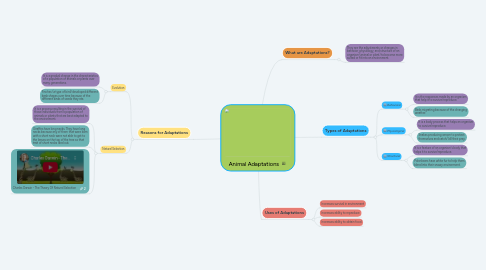
1. Types of Adaptations
1.1. Behavioral
1.1.1. It is the responses made by an organism that help it to survive/reproduce.
1.1.2. Birds migrating because of the changing weather.
1.2. Physiological
1.2.1. It is a body process that helps an organism to survive/reproduce.
1.2.2. Snakes producing venom to protect themselves and catch/ kill their prey.
1.3. Structural
1.3.1. It is a feature of an organism's body that helps it to survive/reproduce.
1.3.2. Polar bears have white fur to help them blend into their snowy environment.
2. Uses of Adaptations
2.1. Increases survival in environment
2.2. Increases ability to reproduce
2.3. Increases ability to obtain food
3. Reasons for Adaptations
3.1. Evolution
3.1.1. It is a gradual change in the characteristics of a population of animals or plants over many generations.
3.1.2. Finches (a type of bird) developed different beak shapes over time because of the different kinds of seeds they ate.
3.2. Natural Selection
3.2.1. It is a process resulting in the survival of those individuals from a population of animals or plants that are best adapted to the environment.
3.2.2. Giraffes have long necks. They have long necks because any of them that were born with a short neck were not able to get to the leaves on the top of the tree so that trait of short necks died out.
3.2.3. Charles Darwin - The Theory Of Natural Selection

